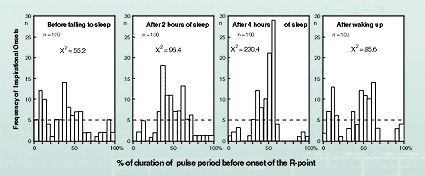Besides such intensifying of the harmonic frequency orders (so-called frequency co-ordination), it has been shown that the phase connections of the rhythmic functions are regulated more strictly among themselves, e.g. during nocturnal sleep (so-called phase co-ordination). Illustration 14 shows frequency distributions of the onset of 100 inhalations in relation to the heart period measured by R-Point to R-Point in the electrocardiogram and divided into classes of 5% of the heart periodic duration. While before falling asleep only slightly increasing frequencies in certain intervals of the heart period can be detected in the healthy test subject, the inspiration beginnings concentrate after some hours of sleep almost totally on a narrow area of the heart cycle in the sense of pulse phase synchronous inhaling.

